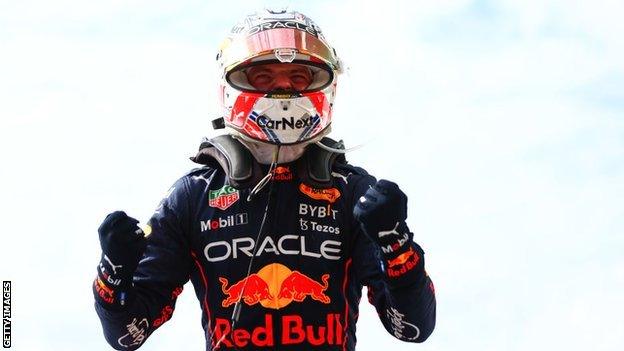United States GP: Lewis Hamilton & Fernando Alonso grab some of Red Bull’s limelight
- Published
- comments

Red Bull won their fifth constructors' title
What to focus on after a United States Grand Prix that produced probably the best race of the season, with three outstanding story lines?
Max Verstappen fought back from an 11-second pit stop to pass his two biggest rivals and clinch a first constructors' title in nine years for a team that had lost its leader and creator less than 24 hours before.
Lewis Hamilton came as close as he has so far this year to a win, only to succumb to the inevitable and lose out to the Verstappen steamroller in the end.
And Fernando Alonso produced one of the drives of the season - one of the races of his long and illustrious career - to finish seventh in a car damaged in a 180mph crash in which it did a wheelie, smashed back into the ground and then a wall, and he dropped to the back of the field.
Just writing that sentence about Alonso, what he achieved seems impossible, unbelievable. But let's start with Verstappen and Red Bull's crowning achievement.
'Dietrich would have enjoyed that'
The Dutchman clinched his second world title at the last race in Japan, but since then Red Bull's world has been engulfed by the controversy of being found guilty of breaching the budget cap last season.
That subject dominated the weekend in Austin until an hour before qualifying, when the news broke of the death of Red Bull co-owner Dietrich Mateschitz at the age of 78 after a long illness.
After qualifying third, Verstappen spoke movingly in tribute to Mateschitz, and he woke up on race morning determined to honour his memory with a win.
It looked like being easy until a pit-stop problem dropped him to third, behind Hamilton and Ferrari's Charles Leclerc. But such is the pace of the Red Bull that he fought back past both with relative ease to achieve the result he so wanted.
Team principal Christian Horner said: "It was almost as if it had been scripted for him to come back through the field. And I think Dietrich would have quite enjoyed that race from above, to see us overtaking Mercedes with five or six laps to go and win the constructors' world championship. He would have been very proud of that race today."
In the emotion of the moment, it was easy to forget the magnitude of Red Bull's achievement. Although Verstappen clinched the drivers' title last season, Mercedes were still the team of the year. This, though, brings to an end eight years of dominance.
"When we learned of the news yesterday of Dietrich's passing, it was very emotional for the whole team," Horner said, "because he's such a giant of a man and has done so much not just for Red Bull Racing but also for F1.
"So we felt determined to go out and really honour him in a way that would make him proud.
"So there were no black armbands and no minute's silence. There was the embodiment of celebrating him, and the best way to do that was the performance on circuit.
"After eight long years, we have never stopped believing, and never lost sight of our goals, which were to get back on to the top of both world championships and we've done that.
"That is testament to the spirit that he embodied that runs through all of Red Bull."
Does this year herald a new era of domination for Red Bull? Many in F1 fear so, but Horner said it was impossible to predict that now. What he did do, though, was emphatically dismiss any prospect of Red Bull's position changing as a result of the loss of Mateschitz.
Mateschitz, Horner said, was central to the vision of setting up their own factory department to design an in-house engine for the new regulations coming in 2026.
"The future is set," Horner said. "He's put in place a very strong foundation for the future, and with Red Bull becoming a power-unit manufacturer in 2026, that was the missing piece of our jigsaw.
"He had the vision to enable that to happen and just as we've done with the chassis, we will take that same spirit, his spirit, into the future engine company."
'We have to be realistic'
As Verstappen's car sat up on its jacks in the pits, and 11 long seconds went by while the mechanics wrestled with a broken wheel gun on the left front, Mercedes team principal Toto Wolff dared briefly to dream that this might be the day the former champions could finally win a race this season.
The delay put Hamilton in the lead, and Verstappen behind Leclerc. If the Ferrari could hold off the Red Bull for a while, and Hamilton's hard tyres lasted better than Verstappen's mediums, the seven-time champion might just be able to hang on.
Hamilton did his best, but it was not enough. Verstappen made little ground in the first laps after he had passed Leclerc, because he had overheated his tyres in doing so.
But once he had brought their temperatures back under control, he started to reel Hamilton in. The mediums were faster, so was the Red Bull, and Verstappen was helped by the capricious nature of the Mercedes car.
Three wild moments in gusts of wind over two laps - two at Turn 12 and one at Turn One - led to mistakes from Hamilton that cost him 0.7secs. And soon Verstappen was on him. The straight-line speed of the Red Bull did the rest.
Hamilton said: "He had an 11-second stop and was behind Charles. That just shows how much pace he had. To get past Charles, make up the six seconds and pull three seconds ahead of me, that shows some serious speed."
Hamilton, who started the race third as a result of grid penalties for Leclerc and Red Bull's Sergio Perez, has been asked all year whether he thinks he can keep up his unique record of winning a race in every season of his career, and he was again on Sunday.
"We need to be realistic," he said. "The Red Bull car has been the fastest car by far all year and it is still the fastest car. We are in the position we are in through reliability. If Charles and Perez were there, it would have been a different race. We would have been on the third row.
"It was great to start third and fight, but out of true pace they were ahead of us all weekend and they will be for the next three races.
"So, unless something drastic happens to all of them, it's highly unlikely we will have the turn pace to compete with them. But we will give it everything we've got."
How did Alonso do that?
Formula 1's fans' vote gave driver of the day to Sebastian Vettel, and he undoubtedly drove a fine race, which culminated in a daring passing move on Kevin Magnussen's Haas around the outside of a flat-out corner on the last lap. Not bad for a man retiring in three races' time.
Nevertheless, it's a mystery how it did not go to Alonso.
The Spaniard started 14th, another victim of an engine penalty, worked his way up to eighth, had a crash that almost put him on the radar system of the nearby airport, stopped for a new front wing, dropped to the back, and fought his way up to sixth in a damaged car, before being passed by Lando Norris' McLaren on fresher tyres on the final lap.
Immediately after the race, this writer walked with Alonso back to the Alpine area in the paddock.
How did you do that, I asked?
"I don't know," he replied with a smile.
On lap 22, on the first lap after a safety-car period, Alonso crashed into Aston Martin's Lance Stroll, who will be his team-mate next year, as he tried to pass.
His car reared up on two wheels before crashing down again, and hit the wall.
"It was not nice," Alonso said. "When you are up in the air, you are not aware of where you are on track, and I thought that I was much more on the left and obviously if you catch the lateral fence, the metallic one, you spin in the air and do a 360.
"You see these kinds of accidents a lot in IndyCar and they are quite dangerous. So I thought I would end up on that fence.
"When the car landed on track, I thought: 'OK, this is all safe, the car for sure is going to be broken, but this is what it is.' And I drove slowly to the pit, thinking we would retire the car.
"I was surprised when they changed the tyres and front wing and sent me out. I said: 'OK, it's just a test but they will call me in the next lap or whatever.'
"But no, the car was OK when they checked it visually everything was fine. So we kept going.
"The second bad news was that we were going to the end with that set of tyres and it was 32 laps to the end and I thought we would never make it. But it was a good call from the team and good strategy and finishing P7 with a car that was broken in the middle of the race and we were last, it was quite a thing.
"We didn't give up and that is part of our DNA."
The car had some broken aerodynamic parts on the floor and front wheel drum, mainly caused by front wing debris, and a damaged right-hand mirror, which fell off a few laps later and prompted a protest from Haas. That resulted in a penalty that dropped him out of the points, but that should detract nothing from the remarkable nature of what he did.
This is far from the first time Alonso has pulled out a performance that should not be possible from a car that is down on peak performance.
The most dramatic of several examples was in Azerbaijan in 2018, when he dragged his car around one of the longest laps of the season after a crash on the second corner, somehow getting it back to the pits with only one functioning tyre.
The car was missing a huge chunk from its floor, but he climbed up from the back to finish seventh passing his team-mate on the way, just as he did on Sunday in Austin.
In such circumstances, Alonso's supernatural adaptability, the way he can change his driving to compensate for a car's shortcomings, comes to the fore.
"Initially, I felt the car was turning to the left a lot more than to the right," Alonso said. "That was the impression when I left the pit.
"They asked me if the car felt OK and I said: 'The car is very good on the left corners and quite bad on the right corners.' But then during the laps it was getting more and more normal so I am not sure any more about that comment."
How did he think he would look back on this drive?
"I think this is very similar to Baku 2018," he said. "It is a car that should be retired and we don't give up and eventually you finish again in the points (positions) and it is a surprise to everyone."
